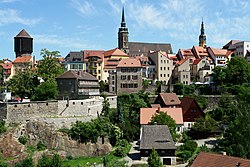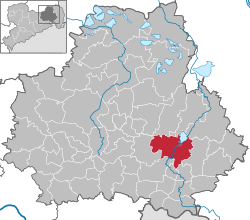
Back Bautzen Afrikaans Bautzen AN باوتسن Arabic باوتسن ARZ Bautzen Azerbaijani Баўтцэн Byelorussian Бауцен Bulgarian Bautzen Breton Bautzen Catalan Баутцен CE
Bautzen
Bautzen/Budyšin | |
|---|---|
 | |
| Coordinates: 51°10′53″N 14°25′27″E / 51.18139°N 14.42417°E | |
| Country | Germany |
| State | Saxony |
| District | Bautzen |
| Subdivisions | 15 |
| Government | |
| • Mayor | Alexander Ahrens (none) |
| Area | |
| • Total | 66.62 km2 (25.72 sq mi) |
| Elevation | 204 m (669 ft) |
| Population (2022-12-31)[1] | |
| • Total | 38,140 |
| • Density | 570/km2 (1,500/sq mi) |
| Time zone | UTC+01:00 (CET) |
| • Summer (DST) | UTC+02:00 (CEST) |
| Postal codes | 02625 |
| Dialling codes | 03591 |
| Vehicle registration | BZ, BIW, HY, KM |
| Website | www.bautzen.de |
Bautzen (![]() [ˈbautsn̩] (help·info), Upper Sorbian: Budyšin, Lower Sorbian: Budyšyn [ˈbudɨʃɨn]; Polish: Budziszyn) is a city in eastern Saxony, Germany, and capital of the Bautzen Rural District.[2] It is on the Spree River.
[ˈbautsn̩] (help·info), Upper Sorbian: Budyšin, Lower Sorbian: Budyšyn [ˈbudɨʃɨn]; Polish: Budziszyn) is a city in eastern Saxony, Germany, and capital of the Bautzen Rural District.[2] It is on the Spree River.
In 2005, 42,189 people lived in Bautzen. Asteroid 11580 Bautzen is named in honour of the city.
Bautzen is historical capital of Upper Lusatia, and it is the most important cultural centre of the Sorbs, a Slavic minority.
During World War II and the Nazi era, there was a subcamp of the Groß-Rosen concentration camp in Bautzen. Ernst Thälmann was imprisoned there before being deported to Buchenwald.
After the war Bautzen was well known in the German Democratic Republic because of its prison. Bautzen I was used as an official prison, Bautzen II was a secret prison for prisoners of conscience (people arrested for their political beliefs, not because of an ordinary crime). Bautzen I is still used as a prison, and Bautzen II has been a memorial since 1993.
In 2002 the city commemorated its thousandth birthday.
- ↑ "Einwohnerzahlen nach Gemeinden als Excel-Arbeitsmappe" (XLS) (in German). Statistisches Landesamt des Freistaates Sachsen. 2024.
- ↑ KRELL, Detlef. Oberlausitz, Lausitzer Seenland. 3. vyd. Bielefeld: Reise Know-How Verlag Peter Rump GmbH, 2017. 396 s. ISBN 978-3-8317-2920-3. Kapitola Bautzen – Hauptstadt der Oberlausitz, s. 39. (německy)



